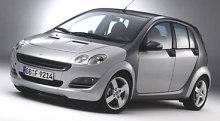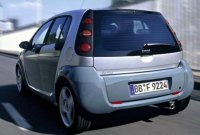 Smart
was originally intended to be a niche car specialist, selling cars
designed
and made by a philosophy different from the mainstream, just like its
parent
company Swatch versus other watch makers. However, the Smart brand was
not profitable throughout the years. Swatch eventually evacuated and
sold
all its stakes to DaimlerChrysler. The German understood that to turn
around
Smart it needs a more mainstream model - it must be a 4-seater (hence
the
name Forfour) using conventional mechanicals so that it can share parts
and platform with Mitsubishi, another subsidiary of DaimlerChrysler.
They
decided to produce the Forfour together with sister car Mitsubishi Colt
at the Nedcar plant in Holland, which was originally a 50-50 joint
venture
between Volvo and Mitsubishi but then DaimlerChrysler bought the
remaining
50% for this project. Smart
was originally intended to be a niche car specialist, selling cars
designed
and made by a philosophy different from the mainstream, just like its
parent
company Swatch versus other watch makers. However, the Smart brand was
not profitable throughout the years. Swatch eventually evacuated and
sold
all its stakes to DaimlerChrysler. The German understood that to turn
around
Smart it needs a more mainstream model - it must be a 4-seater (hence
the
name Forfour) using conventional mechanicals so that it can share parts
and platform with Mitsubishi, another subsidiary of DaimlerChrysler.
They
decided to produce the Forfour together with sister car Mitsubishi Colt
at the Nedcar plant in Holland, which was originally a 50-50 joint
venture
between Volvo and Mitsubishi but then DaimlerChrysler bought the
remaining
50% for this project.
What makes the Smart Forfour unlike mainstream hatchbacks is the radical styling and packaging. It looks so unique in the class ! although the chassis is a conventional steel monocoque, it uses plastic body panels at doors, bonnet, bumpers and fenders and colors them differently from the steel chassis. This is refreshing to eyes and give it strong family resemblance to the city car Fortwo. Inside, the cabin is colorful and full of design language. The fabric used and grain on plastic have quality feel.
All petrol engines come directly from Mitsubishi while diesel engines come from Mercedes A-class. The petrol engines look powerful on paper (75hp for 1.1, 95hp for 1.3 and 109hp for 1.5) but the torque delivery is peaky. Fortunately, the 4-seater Smart weighs less than a ton thus it goes briskly. Both the Mitsubishi 5-speed manual and Smart’s own 6-speed semi-automatic gearbox shift nicely, but refinement is spoiled by the noisy engine. The Forfour is
considerably
more expensive than other mainstream hatchbacks. For a niche car like
BMW
Mini, charging premium price is fully acceptable. For a car which looks
niche but drives ordinarily, whether it worth the extra money is
questionable. |
| The above report was last updated on 12 Mar 2004. All Rights Reserved. |
 Mitsubishi
Colt went on sale in Japan in November 2002, more than a year before
the
Forfour made its European debut. Moreover, the Colt is built in both
Japan
and Holland in a much higher volume than the Smart, so one can easily
see
the platform was primarily developed by Mitsubishi’s engineers in Japan
for the Colt and adapted for the Smart. Both cars share the 2500mm
wheelbase
and have a similar mono-box profile, though the Smart is shorter and
lower.
Its interior space cannot match the Colt, but being a niche car it is
by
all means decent, unlike BMW’s Mini. It can sit 4 proper size adults
and
the rear bench is pretty flexible - 60/40 split and slides back and
forth
for 15cm.
Mitsubishi
Colt went on sale in Japan in November 2002, more than a year before
the
Forfour made its European debut. Moreover, the Colt is built in both
Japan
and Holland in a much higher volume than the Smart, so one can easily
see
the platform was primarily developed by Mitsubishi’s engineers in Japan
for the Colt and adapted for the Smart. Both cars share the 2500mm
wheelbase
and have a similar mono-box profile, though the Smart is shorter and
lower.
Its interior space cannot match the Colt, but being a niche car it is
by
all means decent, unlike BMW’s Mini. It can sit 4 proper size adults
and
the rear bench is pretty flexible - 60/40 split and slides back and
forth
for 15cm.  Despite
of the unconventional look, the Smart Forfour drives conventionally.
The
front strut and rear torsion-beam suspensions work like other
mainstream
hatchbacks and its tuning is no match with BMW Mini. Lack of steering
feel
(again, because this is an electrically assisted rack) and lack of
throttle
steer means the car is never as fun to drive as its look suggest.
Despite
of the unconventional look, the Smart Forfour drives conventionally.
The
front strut and rear torsion-beam suspensions work like other
mainstream
hatchbacks and its tuning is no match with BMW Mini. Lack of steering
feel
(again, because this is an electrically assisted rack) and lack of
throttle
steer means the car is never as fun to drive as its look suggest.